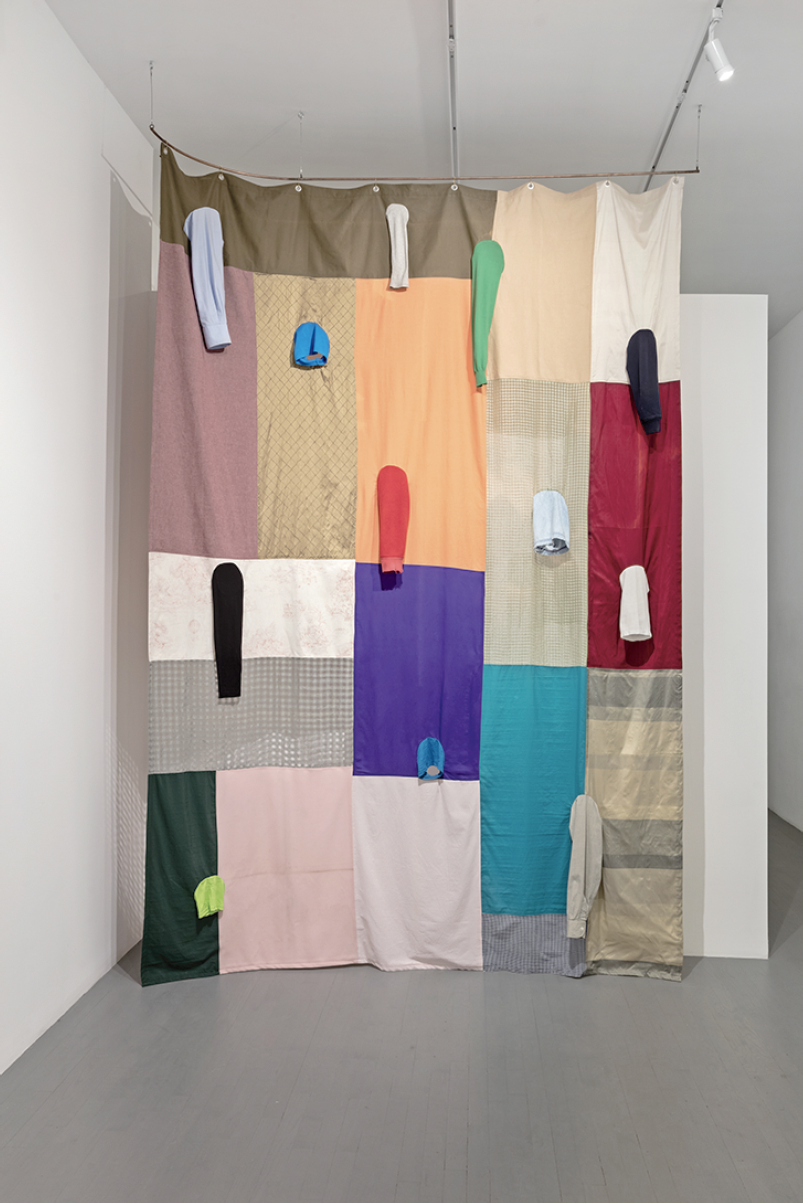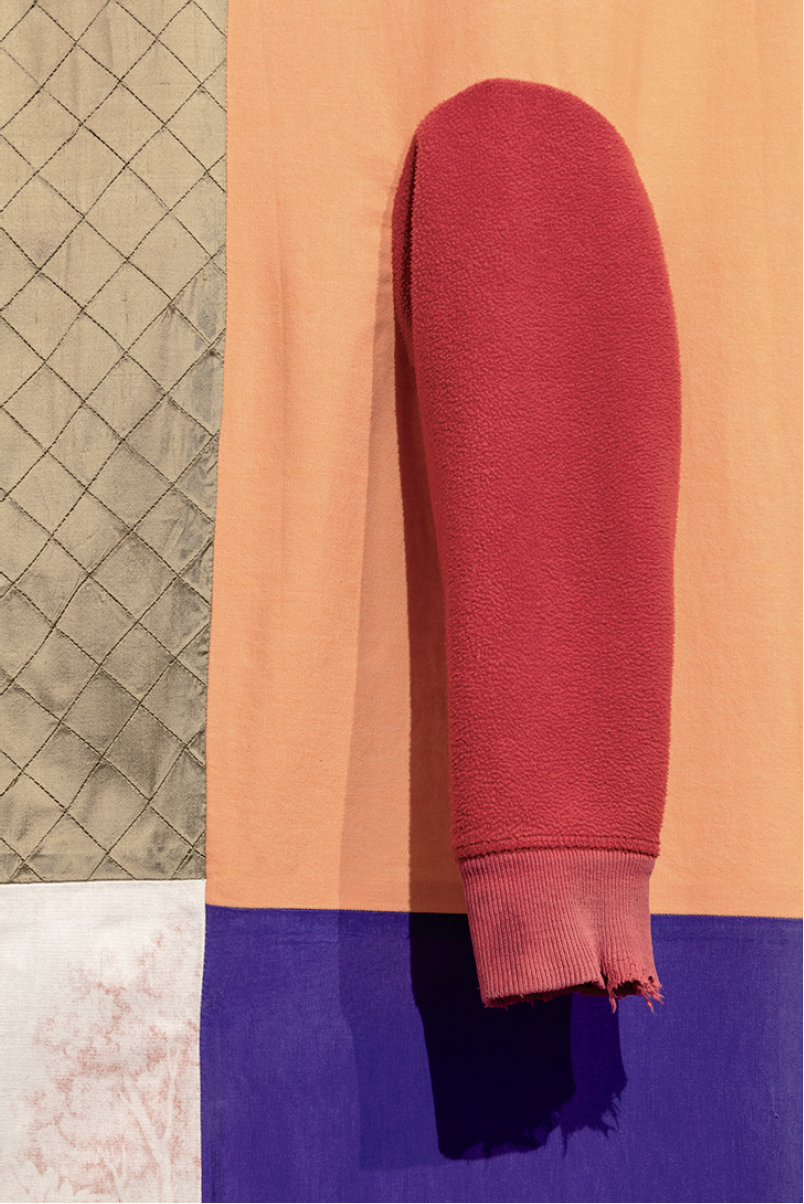Lili Huston-Herterich
Shrewd, subtle, altogether singular—Lili Huston-Herterich’s introductory exhibition with Zalucky Contemporary (which announced its representation of her work two months afterward) confidently wrenched the roles of techniques and materials so as to reconsolidate their basic properties and open them to a range of new expressive potential. The foremost case for this was made by eight photograms that studded—yes, such was their heft—the gallery’s longitudinal walls. These powerfully constructed pieces established a physical mantle and philosophical horizon line from which all the other beguiling components of Huston-Herterich’s project drew direction.
An argument can be made that a photogram is an altogether distinctive compound from a photograph. Etymologically, photograph means “light writing,” whereas a photogram signifies “light message.” Classically in photography, reflected light inscribes itself through the optical mechanisms of aperture and camera that register its binding physics into a natural image upon a photosensitive plane. The camera operator is external, in fact artistic, according to the decisive moment. By contrast, the production of a photogram situates the artist within a darkroom (analogous to a camera) wherein she manipulates objects on a table that will impede and filtrate the exposure of a photosensitive surface and substance to an artificially controlled pool of light. The process is manual, rather than optical, and intrinsically subjective.

Lili Huston-Herterich, The March of the Middling Sort, 2017, sleeves, cotton, silk and linen upholstery fabric, grommets, copper patina on steel rod. All photos: Toni Hafkenscheid. All images courtesy of the artist and Zalucky Contemporary, Toronto.
Huston-Herterich’s practice has been quite variegated with respect to strategy and production. She has shown a consistent tendency to collaboration, which has generated teamwork within which she might play creative partner, contributor, correspondent, conversant or curator, any of which, in turn, satisfies her balanced artistic identity. For “We of the Middling Sort,” before she began to firmly conceive, let alone make, any of the works, she sought input from the community in the immediate surrounds of Zalucky Contemporary, located in an historic Toronto district known as The Junction, named for the railway lines converging toward the heart of the city. The Junction is a lapsed manufacturing area, now with a renewed residency in the former homes of labourers and economic renewal by artisans and cottage industries—a mixed, middling, transitional sundry.
The community responded to her solicitations with donations of garments no longer in use, and, from an upholsterer, out-of-date textile samples. Huston-Herterich employed the former for her photograms, seeking their inherent qualities to speak to the nature and condition of dressing. For example, a splayed tie-dyed top (titled Being There) expresses the attitude of response and expansion into the moment. Its non-pattern modulated the passage of light through lightweight material. The images are printed on ample sheets of watercolour paper (which add their own substrate of dense, fibrous texture), about 20 x 16 inches; however, the technique works on a 1:1 scale, so even that size is a tight squeeze for articles designed for the body. As a result, the prints simultaneously invert the condition of clothing, being fit within the standardized measurement of the paper. That, combined with the flatbed nature of the photogram, seems to have informed Huston-Herterich’s sensitivity to the treatment of the various items, portrayed as open, nude, perhaps fresh from the laundry but not yet folded. Buttonholes are flared from use, seams a bit overstretched. A pair of pants with an out-turned pocket is titled Being Broke. Huston-Herterich accentuated its flaccid quality with an overlay of hapless machine stitching (done on a sheet of clear Mylar). A comparable gesture endows an internal gastric loop in the pit of a slender jersey (Being Hungry). The photograms, of course, are negative images, enigmatic, spectral, colourless, as if excavated from burial after long banishment from the light of day. They also essentially become drawings, an interpretation that Huston-Herterich encourages by placing them within broad– bordered (five-inch) mats that she has vigorously rubbed nearly black with charcoal.

The March of the Middling Sort, detail.
The handling of the photograms is also sculptural. Their solid construction literally supports several complementary object works, made from the same pool of donated clothing, that hang from steel rods resting on their picture frames. These have cooler, more matter-of-fact, captionlike titles than the compassionate ones of the photogram series. Jean Leg hangs in the gap between Being Hungry and Being Broke, a denim leg eviscerated to what is basically a rugged exoskeleton, comprised of waist, inseam and cuff, its back pocket loosely slung in position by jewellers’ chain that runs through a quadrant of brass grommets. The interior front pocket, sewn into the pattern, echoes the empty pocket of Being Broke. Men on Vacation similarly reduces a pair of summer sports shirts to their extremities of seam-work and collars. By comparison, Breasts in a T-shirt has a complex deconstruction. More of its material has been left in place—the front split down its meridian into divided panels, short, gentle arcs of aluminum tubing indicating the absent breasts, a paradoxical integration of modesty and display. All three works also incorporate another bodily surrogate: porcelain clumps formed from the insides of clenched fists. Left and right are tethered like a pair of mittens with a length of chain, draped to the sides of the works, appropriately suggesting invisible bodies donning the barest remnants of apparel.
The phantoms of such determined fists are finally conjured in a large, quilt-like curtain that draped the back of the gallery, titled The March of the Middling Sort. The upholstery samples form pageant-like patchwork banners, configured in no-nonsense squares and rectangles, nonetheless bright and positive. Off from the curtain protrude a dozen solid-colour sleeves, long and short, small and large, randomly enough placed to jumble into a microcosmic crowd. Their sizes suggest a mix of adults and children, possibly men with women, although they seem predominantly female. A few of the cuffs have been frayed by nervous fingers. This is the backdrop of street theatre, a gathering of the community, the realization of untapped power—Huston- Herterich’s reciprocal acknowledgement to her donors. ❚
“We of the Middling Sort” was exhibited at Zalucky Contemporary, Toronto, from February 23 to March 25, 2017.
Ben Portis was a Toronto-based writer and curator. He died in a road accident in Toronto in July of this year. He was a frequent and valued contributor to Border Crossings.

